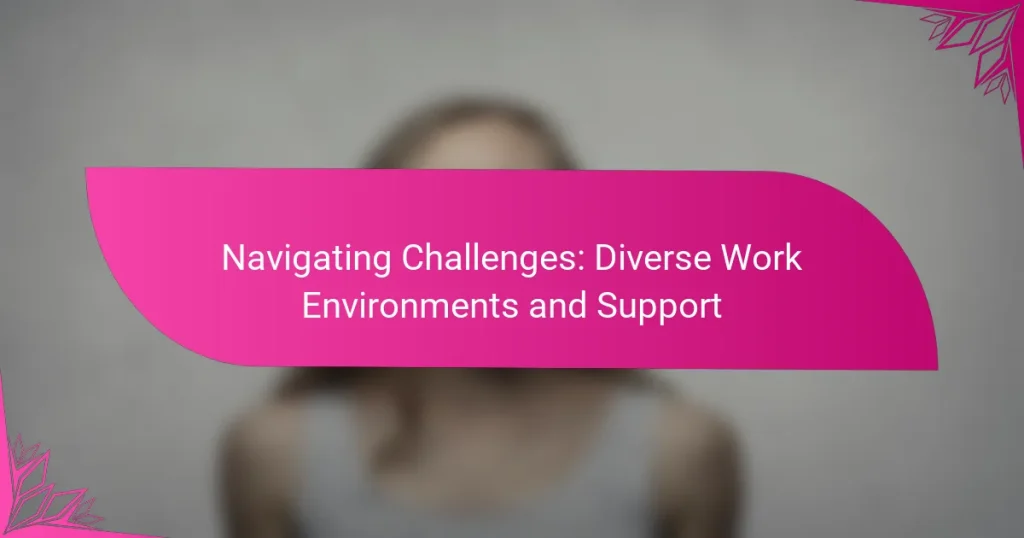Navigating the complexities of diverse work environments requires organizations to adopt strategies that foster inclusivity and respect among all employees. By addressing challenges such as cultural misunderstandings and communication barriers, companies can enhance collaboration and productivity. Implementing flexible work arrangements and utilizing technology can further support a cohesive and supportive workplace culture.
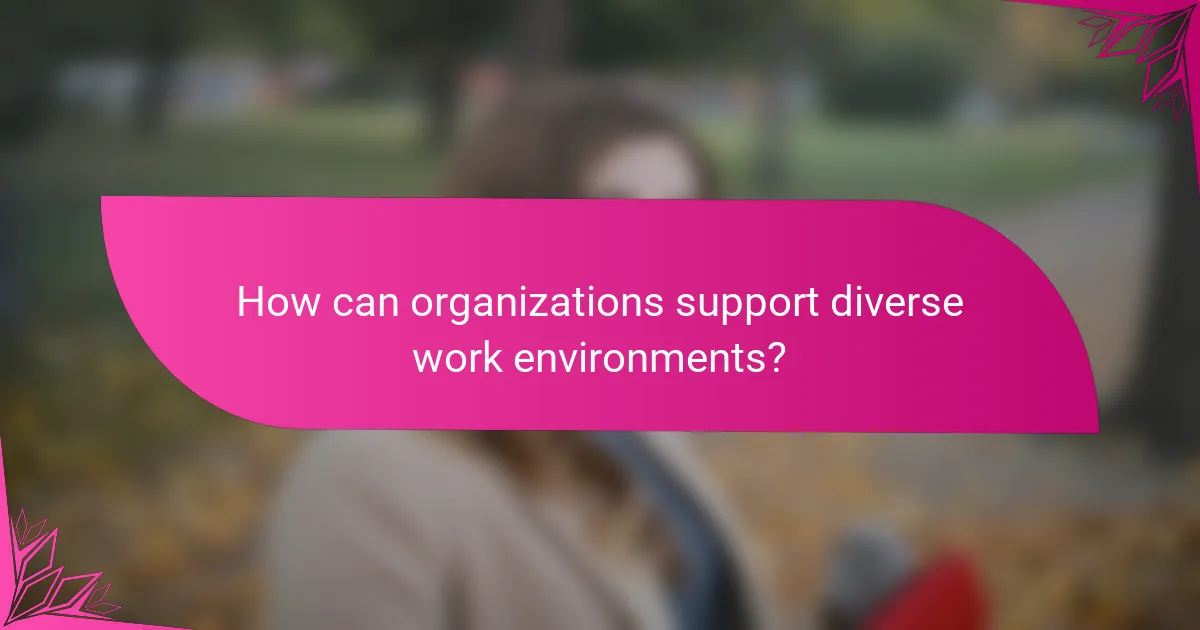
How can organizations support diverse work environments?
Organizations can support diverse work environments by implementing strategies that promote inclusivity and respect for all employees. Key approaches include flexible work arrangements, diversity training programs, employee resource groups, and inclusive hiring practices.
Flexible work arrangements
Flexible work arrangements allow employees to choose when and where they work, accommodating various personal needs and lifestyles. This can include options like remote work, flexible hours, or compressed workweeks, which can enhance job satisfaction and productivity.
Organizations should consider offering a variety of flexible options to meet diverse employee needs. For example, some employees may prefer to work from home several days a week, while others may benefit from staggered start times to manage family responsibilities.
Diversity training programs
Diversity training programs educate employees about the importance of inclusivity and equip them with skills to navigate diverse work environments. These programs can cover topics such as unconscious bias, cultural competence, and effective communication across differences.
Implementing regular training sessions can foster a more inclusive workplace culture. Organizations should ensure that training is interactive and relevant, using real-life scenarios to engage participants and encourage open discussions.
Employee resource groups
Employee resource groups (ERGs) are voluntary, employee-led groups that foster a sense of community and support among individuals with shared identities or experiences. ERGs can provide networking opportunities, mentorship, and a platform for discussing workplace challenges.
Organizations should support the formation of ERGs by providing resources and visibility. For instance, they can allocate time during work hours for meetings and ensure that ERGs have a voice in company decision-making processes.
Inclusive hiring practices
Inclusive hiring practices focus on attracting and selecting a diverse pool of candidates, ensuring that recruitment processes are fair and equitable. This can involve using diverse interview panels, standardizing interview questions, and actively seeking candidates from underrepresented backgrounds.
Organizations should regularly review their hiring policies and practices to identify potential biases. Implementing blind recruitment techniques, where personal information is removed from applications, can help create a more level playing field for all candidates.

What challenges do diverse work environments face?
Diverse work environments encounter several challenges that can impact collaboration and productivity. Key issues include cultural misunderstandings, communication barriers, and resistance to change, each requiring tailored strategies for effective management.
Cultural misunderstandings
Cultural misunderstandings arise when team members interpret behaviors, expressions, or practices through their own cultural lens. This can lead to misinterpretations and conflict, undermining teamwork. For example, direct communication may be valued in some cultures, while others may prefer a more indirect approach.
To mitigate these misunderstandings, organizations should promote cultural awareness through training and workshops. Encouraging open discussions about cultural differences can also foster a more inclusive environment.
Communication barriers
Communication barriers in diverse workplaces often stem from language differences and varying communication styles. Employees may struggle to convey their thoughts clearly, leading to frustration and inefficiency. For instance, a team member who speaks English as a second language might hesitate to share ideas due to fear of miscommunication.
Employing clear, simple language and providing translation resources can help bridge these gaps. Regular check-ins and feedback sessions can also ensure that everyone is on the same page and feels comfortable expressing their views.
Resistance to change
Resistance to change is a common challenge in diverse environments, often fueled by differing values and beliefs. Employees may resist new policies or practices that they perceive as threatening to their established norms. For example, implementing a new collaborative tool may be met with skepticism from those accustomed to traditional methods.
To address this resistance, leaders should involve employees in the change process, seeking their input and addressing concerns. Providing training and demonstrating the benefits of new approaches can also ease transitions and foster acceptance.
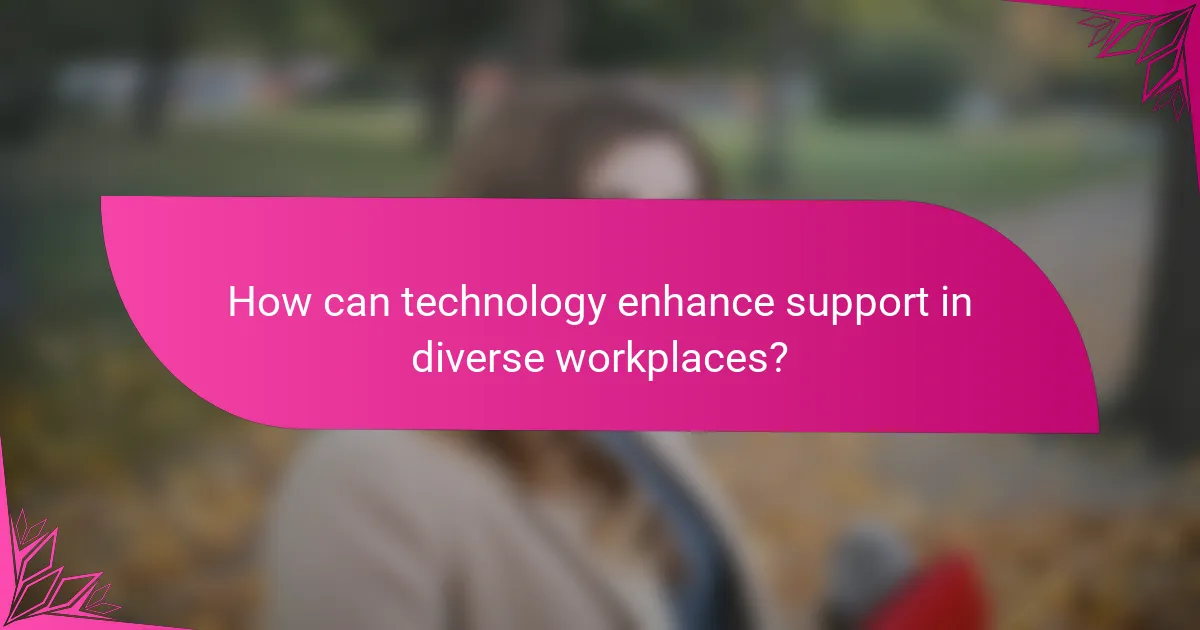
How can technology enhance support in diverse workplaces?
Technology can significantly enhance support in diverse workplaces by facilitating communication, training, and feedback among employees from various backgrounds. By leveraging advanced tools, organizations can create inclusive environments that cater to the unique needs of their workforce.
Collaboration tools like Slack
Collaboration tools such as Slack streamline communication in diverse workplaces by allowing team members to connect in real-time, regardless of their location. These platforms support various channels for discussions, making it easier to organize conversations by project or topic.
Using features like direct messaging and file sharing, employees can quickly exchange information and collaborate effectively. To maximize the benefits, organizations should encourage the use of these tools for both formal and informal interactions, fostering a sense of community among team members.
Virtual reality training
Virtual reality (VR) training offers immersive learning experiences that can cater to diverse learning styles and backgrounds. By simulating real-world scenarios, VR training allows employees to practice skills in a safe environment, enhancing their confidence and competence.
Companies should consider integrating VR training modules that address specific challenges faced by diverse teams, such as cultural sensitivity or conflict resolution. This approach not only improves engagement but also promotes a deeper understanding of diverse perspectives within the workplace.
AI-driven feedback systems
AI-driven feedback systems can provide personalized insights to employees, helping them understand their performance and areas for improvement. These systems analyze data from various sources, offering tailored recommendations that consider individual strengths and weaknesses.
Implementing such systems can help organizations identify trends and address potential biases in feedback, ensuring that all employees receive fair evaluations. Regularly reviewing AI-generated insights can also foster a culture of continuous improvement and support among diverse teams.
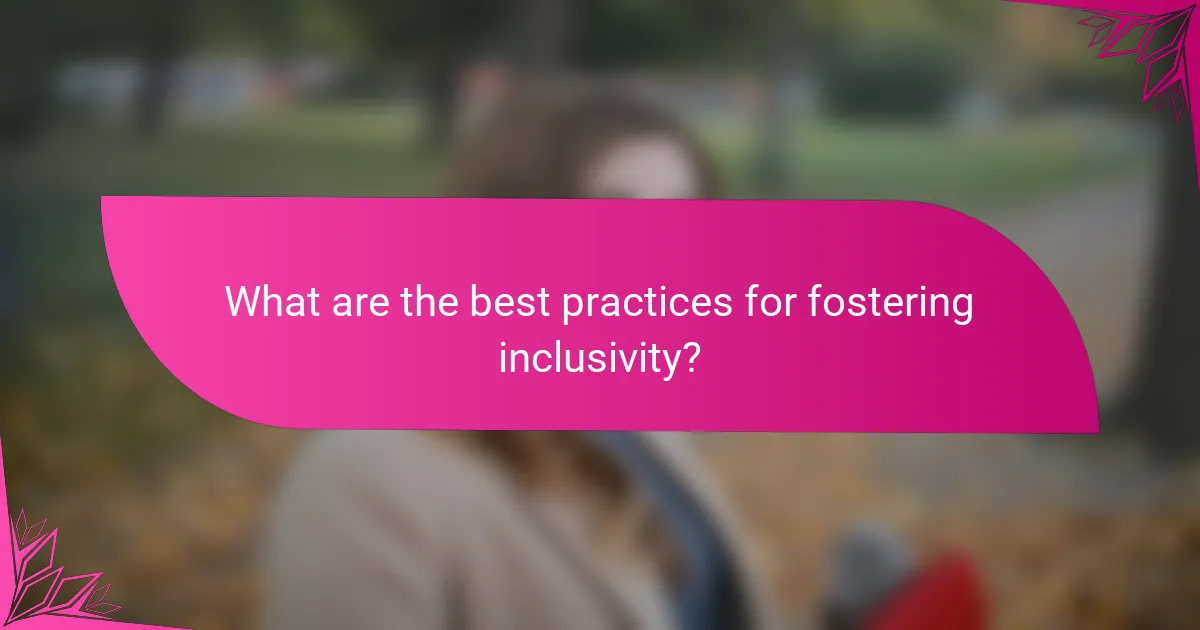
What are the best practices for fostering inclusivity?
Fostering inclusivity in diverse work environments involves implementing strategies that promote equal participation and respect for all individuals. Best practices include creating regular feedback mechanisms, establishing mentorship programs, and celebrating cultural events to enhance understanding and collaboration among team members.
Regular feedback mechanisms
Regular feedback mechanisms are essential for fostering inclusivity as they provide a platform for employees to express their thoughts and experiences. Implementing anonymous surveys or suggestion boxes can help gather honest feedback about workplace culture and inclusivity efforts.
Consider scheduling quarterly feedback sessions where employees can discuss their experiences and suggest improvements. This not only empowers individuals but also helps management identify areas needing attention.
Mentorship programs
Mentorship programs can significantly enhance inclusivity by pairing employees from diverse backgrounds with experienced mentors. This relationship fosters personal and professional growth, allowing mentees to navigate challenges and develop skills in a supportive environment.
To create an effective mentorship program, consider matching mentors and mentees based on shared interests or career goals. Regular check-ins can help ensure that the mentorship remains productive and beneficial for both parties.
Celebrating cultural events
Celebrating cultural events in the workplace promotes inclusivity by recognizing and valuing the diverse backgrounds of employees. Organizing events such as cultural potlucks, festivals, or awareness days can enhance team bonding and cultural appreciation.
Encourage participation by allowing employees to share their traditions and customs. This not only educates the team but also fosters a sense of belonging and respect for different perspectives within the workplace.

What metrics can measure diversity success?
Measuring diversity success involves evaluating various metrics that reflect an organization’s commitment to inclusivity. Key metrics include employee satisfaction surveys, diversity hiring statistics, and retention rates, each providing insights into the effectiveness of diversity initiatives.
Employee satisfaction surveys
Employee satisfaction surveys are essential tools for gauging how diverse employees feel about their workplace. These surveys can include questions about inclusivity, respect, and support from management, allowing organizations to identify areas needing improvement.
To effectively measure satisfaction, consider using a mix of quantitative ratings and qualitative feedback. Aim for a response rate of at least 70% to ensure the results are representative of the entire workforce.
Diversity hiring statistics
Diversity hiring statistics track the demographics of new hires compared to the overall labor market. This metric helps organizations assess whether their recruitment strategies are attracting a diverse pool of candidates.
To analyze these statistics, compare the percentage of hires from underrepresented groups against industry benchmarks. Aiming for a gradual increase in diversity hiring rates over time can indicate progress in your diversity initiatives.
Retention rates
Retention rates measure how well an organization keeps its diverse employees over time. High turnover among diverse groups may signal issues with workplace culture or support systems.
To improve retention, regularly review exit interview data and identify trends related to diversity. Implementing mentorship programs and professional development opportunities can help enhance retention among diverse employees.
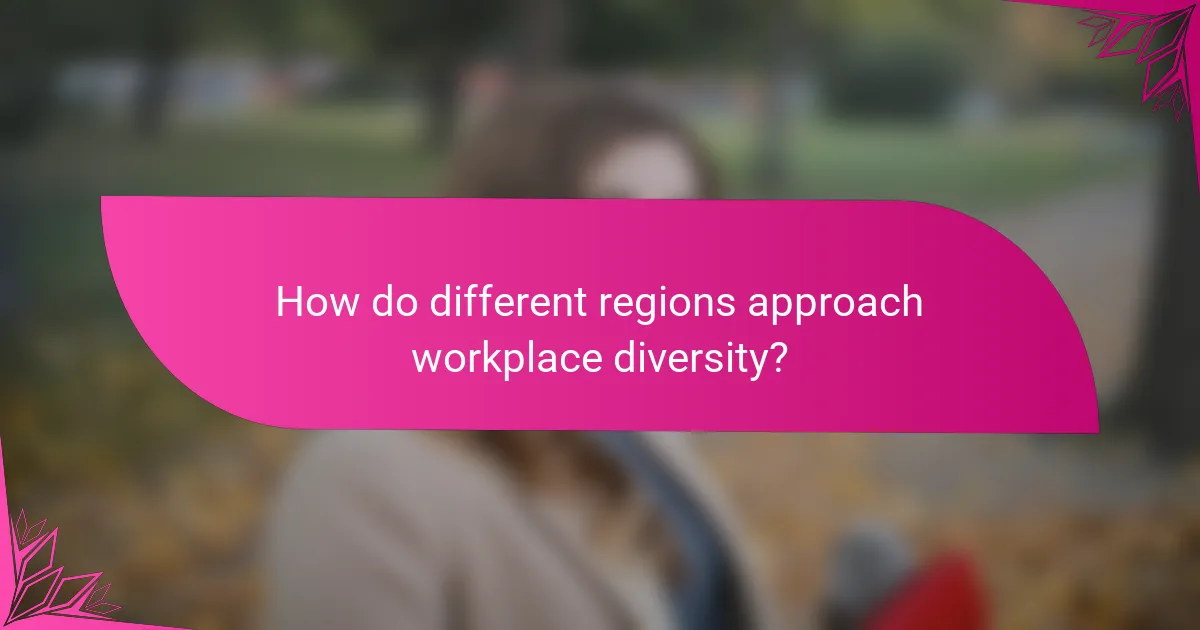
How do different regions approach workplace diversity?
Regions vary significantly in their approach to workplace diversity, influenced by cultural, legal, and economic factors. Understanding these differences can help organizations tailor their diversity initiatives to be more effective and inclusive.
North America
In North America, particularly the United States and Canada, workplace diversity is often driven by legal frameworks and corporate policies. The U.S. has laws like the Civil Rights Act, which prohibits discrimination based on race, gender, and other characteristics, while Canada emphasizes multiculturalism and inclusivity through its Employment Equity Act.
Companies in this region frequently implement diversity training programs and set measurable diversity goals. For instance, many organizations aim for representation across various demographics, often targeting a workforce that reflects the community’s diversity.
Europe
European countries approach workplace diversity through a mix of EU regulations and national laws. The EU promotes equality through directives that encourage member states to adopt anti-discrimination measures. Countries like Sweden and the Netherlands are known for their progressive policies, emphasizing gender equality and inclusion of minorities.
In practice, organizations may adopt quotas or targets for gender representation on boards, as seen in Norway. However, the approach can vary; some countries focus more on voluntary measures rather than enforced quotas.
Asia
In Asia, the approach to workplace diversity can be quite diverse itself, influenced by cultural norms and economic conditions. Countries like Japan and South Korea have traditionally been less diverse, but there is a growing recognition of the need for inclusivity, especially in multinational corporations.
For example, businesses in India often focus on gender diversity, with initiatives aimed at increasing female representation in leadership roles. However, challenges such as societal expectations and workplace culture can hinder progress.
Australia
Australia promotes workplace diversity through both legislation and a strong emphasis on corporate responsibility. The Equal Opportunity Act mandates non-discrimination, and many organizations actively pursue diversity initiatives to foster inclusive workplaces.
Australian companies often engage in community outreach and partnerships with Indigenous groups to enhance representation. Additionally, many firms publish annual diversity reports to track progress and hold themselves accountable.
